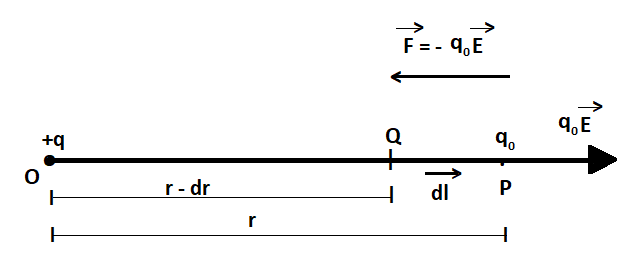
In the direction of electric field, the electric potential:
A. Decreases.
B. Increases.
C. Remains unchanged.
D. Becomes zero.
Answer
509.4k+ views
Hint: We will use the idea of the electric field as a gradient of potential to answer this problem. We are going to solve this problem using the relationship \[E = - \dfrac{{dv}}{{dr}}\].
Complete step by step answer:

We know that in an electrical field the electrical potential between two points A and B is defined as the amount of work performed per unit of positive test charge in moving it against the electrostatic force due to the electrical field from point A to point B.
If $dW$ is the work done in moving a small positive test charge ${q_0}$ from point P to Q, then
$ \Rightarrow (V + dV) - V = \dfrac{{dW}}{{{q_0}}}$.
$ \Rightarrow dV = \dfrac{{dW}}{{{q_0}}}$ ………..(i)
And, if $\overrightarrow E $ is the electric field at point P due to charge +a place at point O, then the test charge experiences a force equal to ,
$ \Rightarrow \overrightarrow F = {q_0}\overrightarrow E $.
Therefore, work done to move the test charge through an infinitely small displacement $PQ = dl$is given by
$dW = \overrightarrow F .\overrightarrow {dl} $
and we have $\overrightarrow F = {q_0}\overrightarrow E $, then
$dW = {q_0}\overrightarrow E .\overrightarrow {dl} = ({q_0}\overrightarrow E ).\overrightarrow {dl} \cos {180^0}$ [ ]
$dW = - {q_0}E.dl$ ……..(ii)
As the distance r decreases in the direction of $\overrightarrow {dl} $, the distance dl is taken as dr.
So now, form equation (ii), we get
$
dW = - {q_0}E.dr \\
\dfrac{{dW}}{{{q_0}}} = - E.dr \\
$
From equation (i), we have $dV = \dfrac{{dW}}{{{q_0}}}$, then
$
dV = - Edr \\
E = - \dfrac{{dV}}{{dr}} \\
$.
Therefore the electric field at a point is equal to the negative gradient of the electric potential at that point.
The negative sign indicates that the direction of E is always in the direction of decreased potential.
Hence, we can say that, In the direction of electric field, the electric potential decreases.
Therefore the correct answer is option (A).
Note: In this type of questions, first we have to identify what relationship of the given terms is required to solve the question. Then we will assume some conditions and prove the statement step by step. While solving the question, we have to remember the significance of the signs. After that we will get the required answer.
Complete step by step answer:

We know that in an electrical field the electrical potential between two points A and B is defined as the amount of work performed per unit of positive test charge in moving it against the electrostatic force due to the electrical field from point A to point B.
If $dW$ is the work done in moving a small positive test charge ${q_0}$ from point P to Q, then
$ \Rightarrow (V + dV) - V = \dfrac{{dW}}{{{q_0}}}$.
$ \Rightarrow dV = \dfrac{{dW}}{{{q_0}}}$ ………..(i)
And, if $\overrightarrow E $ is the electric field at point P due to charge +a place at point O, then the test charge experiences a force equal to ,
$ \Rightarrow \overrightarrow F = {q_0}\overrightarrow E $.
Therefore, work done to move the test charge through an infinitely small displacement $PQ = dl$is given by
$dW = \overrightarrow F .\overrightarrow {dl} $
and we have $\overrightarrow F = {q_0}\overrightarrow E $, then
$dW = {q_0}\overrightarrow E .\overrightarrow {dl} = ({q_0}\overrightarrow E ).\overrightarrow {dl} \cos {180^0}$ [ ]
$dW = - {q_0}E.dl$ ……..(ii)
As the distance r decreases in the direction of $\overrightarrow {dl} $, the distance dl is taken as dr.
So now, form equation (ii), we get
$
dW = - {q_0}E.dr \\
\dfrac{{dW}}{{{q_0}}} = - E.dr \\
$
From equation (i), we have $dV = \dfrac{{dW}}{{{q_0}}}$, then
$
dV = - Edr \\
E = - \dfrac{{dV}}{{dr}} \\
$.
Therefore the electric field at a point is equal to the negative gradient of the electric potential at that point.
The negative sign indicates that the direction of E is always in the direction of decreased potential.
Hence, we can say that, In the direction of electric field, the electric potential decreases.
Therefore the correct answer is option (A).
Note: In this type of questions, first we have to identify what relationship of the given terms is required to solve the question. Then we will assume some conditions and prove the statement step by step. While solving the question, we have to remember the significance of the signs. After that we will get the required answer.
Recently Updated Pages
Master Class 10 General Knowledge: Engaging Questions & Answers for Success

Master Class 10 Computer Science: Engaging Questions & Answers for Success

Master Class 10 Science: Engaging Questions & Answers for Success

Master Class 10 Social Science: Engaging Questions & Answers for Success

Master Class 10 Maths: Engaging Questions & Answers for Success

Master Class 10 English: Engaging Questions & Answers for Success

Trending doubts
Truly whole mankind is one was declared by the Kannada class 10 social science CBSE

Explain the three major features of the shiwaliks class 10 social science CBSE

Distinguish between the reserved forests and protected class 10 biology CBSE

What are the public facilities provided by the government? Also explain each facility

The Equation xxx + 2 is Satisfied when x is Equal to Class 10 Maths

Question An example of homologous organs is a Our arm class 10 biology CBSE




